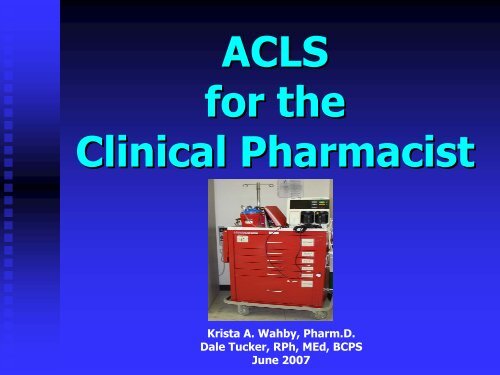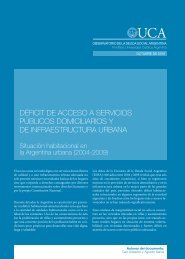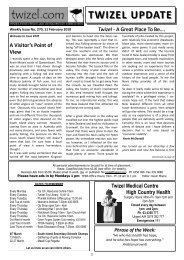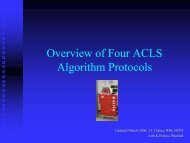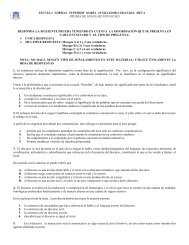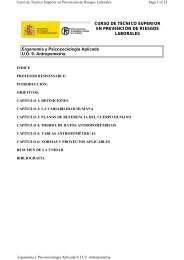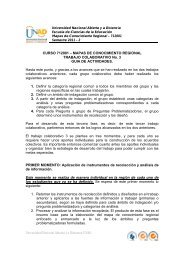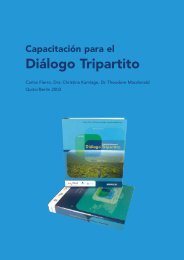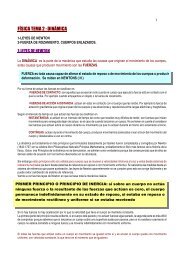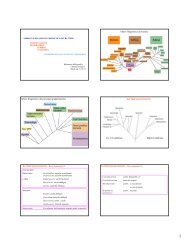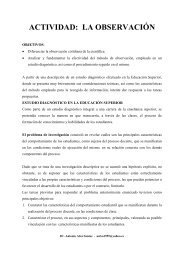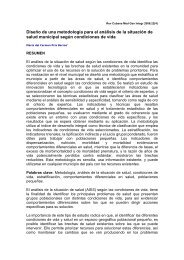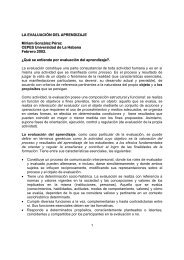ACLS for the Clinical Pharmacist
ACLS for the Clinical Pharmacist - IHMC Public Cmaps (2)
ACLS for the Clinical Pharmacist - IHMC Public Cmaps (2)
- No tags were found...
You also want an ePaper? Increase the reach of your titles
YUMPU automatically turns print PDFs into web optimized ePapers that Google loves.
<strong>ACLS</strong><strong>for</strong> <strong>the</strong><strong>Clinical</strong> <strong>Pharmacist</strong>Krista A. Wahby, Pharm.D.Dale Tucker, RPh, MEd, BCPSJune 2007
Objectives• To review <strong>the</strong> importance of having apharmacist attend codes• To familiarize <strong>the</strong> pharmacist with <strong>the</strong> <strong>ACLS</strong>protocols• To review routes of administration <strong>for</strong>medications used in code blue emergencies• To introduce several common ECG rhythms• To identify and discuss <strong>the</strong> most commondrugs used by <strong>the</strong> <strong>ACLS</strong> algorithms
Why Involve <strong>Pharmacist</strong>?• Improves outcomes in Code Blue Pharmaco<strong>the</strong>rapy 2007. Apr 27(4);481-93. Pharmaco<strong>the</strong>rapy 1999. 19(5);556-64.64.• Calculate drug doses• Drug in<strong>for</strong>mation• Preparation of drugs• Source of quick access <strong>for</strong> medicationsnot on crash cart• Assessment of patient’s allergies andmedication usage
Common Principles in New <strong>ACLS</strong>Guidelines - 20051. Early, effective bystander CPR2. Early defibrillation - Public Access Defibrillation3. Minimal interruptions in chest compressions4. Establishing a specific diagnosis by ECG5. Choose one antiarrhythmic agentOne, and only one antiarrhythmic should be used.6. If IV access is not established, Intraosseouscannulation is <strong>the</strong> first line alternative andendotracheal is an alternative.
<strong>Pharmacist</strong> Involvement• <strong>Pharmacist</strong>s should KNOW:How?Why?…to use an agent…we use an agentWhen? …to use an agentWhat?...to watch <strong>for</strong>
HowTo Use<strong>the</strong>Medication?
Routes of Medications• IV Push (IVP)• Preferred route – fast, convenient,+bioavailability• Peripheral – flush w/ 20cc bolus and elevate arm<strong>for</strong> 10-20 seconds. Peak effect takes 1-212 minutes• Central line should be placed (however, keep inmind it is a relative contraindication <strong>for</strong>thrombolytic <strong>the</strong>rapy)V - vasopressinA – amiodarone, atropine, adenosineL – lidocaineE – epinephrine
Intravenous Infusion• Intravenous infusion Medications <strong>for</strong> continuous IVinfusion only P – procainamide I – isoproterenol N – norepinephrine D – dopamine Central line preferred, however,peripheral OK in emergency
Intraosseous Administration• When IV access notavailable• Gives access to anoncollapsible venousaccess route• Important whenpatients are in shockwith peripheralvasoconstriction
Endotracheal Administration• When IV access is not available• Doses usually 2-2.522.5 times higher• Absorption occurs at alveolar capillary interface• Dilute drugs with 10ml 0.9% NaCl or Water to allow<strong>for</strong> adequate delivery (H2O preferred) L – lidocaine (2-4 4 mg/kg) E – epinephrine (2-2.5 2.5 mg) A – atropine (2-3 3 mg) N – naloxone (0.8-1.6 mg) V – vasopressin (80-100 Units)
HOW?Medication Administration• Do not interrupt chest compressions• Time to maximum effect of drug maydepend on <strong>the</strong> distance from <strong>the</strong> heart• Administer 10-20ml NS after each drugadministered (20ml if peripheraladministration & elevate arm)• Have medications labeled and ready inadvance• Best to give immediately after shock
WHENTo UseWHATMedication?
Use of Algorithms• Meant to treat broadest range of patients• Memory aids• Use “wisely,” not blindly• Not meant to replace clinical judgment Where to find? American Heart Association Attached to crash cart Included in DMC Tier 2 policy acls.net on <strong>the</strong> web
• Wave <strong>for</strong>msCheck RhythmECG Rhythmshealthcentral.org
ECG Rhythms• Normal sinus rhythmhealthcentral.org
ECG Rhythms• Asystole• Bradycardiahealthcentral.org
ECG Rhythms• Ventricular Tachycardia• Ventricular Fibrillationhealthcentral.org
ECG Rhythms• Artifact (wave<strong>for</strong>m interference)healthcentral.org
Cardiac ArrestManagement1. Pulseless Cardiac Arrest – i.e.ASYSTOLE and PEA2. VENTRICULAR FIBRILLATION andPULSELESS V.TACH
Pulseless Arrest Algorithm• Minimize interruptions in chestcompressions• Limit pulse and rhythm checks• Do not check pulse immediatelyafter shock – give 5 cycles, <strong>the</strong>ncheck!• Once advanced airway in place –do not interrupt compressions
Asystole and Pulseless ElectricalActivity (PEA)• Asystole is a cardiac standstill• PEA-pt has mechanical contractions but nopulse. Any rhythm possible• Both are non-shockable rhythms• Most do not survive• Asystole means <strong>the</strong> patient’s life hasended
Asystole & PEA AlgorithmBLS Algorithm:Call <strong>for</strong> help, give CPRGive oxygen when availableAttach monitor/defibrillator when available⇓Check rhythm: shockable? YES or NOIf NO and problem is asystole/PEA⇓Resume CPR immediately <strong>for</strong> 5 cycles⇓Give vasopressor: Epinephrine or vasopressinConsider Atropine <strong>for</strong> asystole or slow PEA rate⇓Give 5 cycles of CPR⇓Check rhythm: shockable? If no:
Asystole and PEA AlgorithmPEAInterventionsProblem search via Differential Diagnosistable; treat accordingly. (PATCH 4MDs)Continue algorithm if indicated.Epinephrine 1 mg IVP/IO q3-5 5 min.ORVasopressin 40 units IV/IO, once, in place of<strong>the</strong> first or second dose of epinephrine.Atropine 1 mg IVP/IO q3-5 5 minutes; 3mgmaximum.
Problem Search: Differential DiagnosisPATCH(4) MDs• Pulmonary embolism• AcidosisThrombolyticsBicarb./hyperventilation• TensionpneumothoraxThoracostomy• CardiactamponadePericardiocentesis• HyperkalemiaHCO3, CaCl, , Ins/GlcGlc, , HD,diuresis, kayexylate• Hypokalemia• Hypovolemia• Hypoxia• Myocardial infarct ACS protocol Avoid BB if cocaine• Drugs• Shivering
BasicPharmacologyReview
Vasoactive Receptor Effects• α1 – VASOCONSTRICTION of arteriesand veins• α2 – Feedback and Vasoconstriction Decreases NE release• β1 – INOTROPE & CHRONOTROPE• β2 – VASODILATION (skin, kidneys,skeletal muscles, visceral andpulmonary arteries) andBRONCHODILATION
Vasopressor Therapy• Increases SBP by increasing preload andventricular filling pressure• Enhance organ perfusion, increase cerebraland coronary perfusion pressures (increasessuccess of defibrillation)• Mostly via α 1 stimulation and V 1 stimulation• List <strong>the</strong> Vasopressors: Epinephrine Vasopressin Norepinephrine Phenylephrine Dopamine
Inotropic Therapy• Increase cardiac contractility andincrease cardiac output (CO)• Work via β1 1 stimulation and/or byincreasing cAMP and Calcium influx• List <strong>the</strong> Inotropes: Dobutamine Milrinone (or inamrinone) Digoxin Glucagon
Catecholamine Pharmacology• Bind to β–adrenoreceptor and stimulate Gsprotein• Stimulates adenylate cyclase, cAMP• cAMP acts to INCREASE Ca INFLUX• VASOCONSTRICTION, INOTROPY
E = Epinephrine• 1mg IVP/IO every 3-535 minutes.GOAL – Improve Perfusion to Essential Organs(Heart, Brain). Shifts blood centrally.• MOA – Alpha and Beta Adrenergic Agonist α1 – Vasoconstriction. Increases BP;improves cerebral and coronary perfusionpressures β 1-2- Stimulates <strong>the</strong> cardiac muscleincreasing <strong>the</strong> strength of ventricularcontraction. + inotrope and chronotrope.Does increase myocardial work
Epinephrine Side Effects• Nervous system: anxiety, agitation• Cardiovascular: dilated CM, LVdysfunction• Psychiatric: disorientation,hallucinations• Metabolic: acidosis, hypokalemia• Renal: renal insufficiency• O<strong>the</strong>r: extravasation, skin necrosis
Vasopresssin• Vasopressin 40 units IVP/IO x 1 (2 vialsrequired. Each vial = 20 Units)• May replace 1st or 2 nd dose of epinephrine• Pharmacology: : Endogenous ADH Causes vasoconstriction at high doses bydirectly stimulating smooth muscle V 1receptors Dilates cerebral blood vessels Coronary & renal vasoconstriction
Vasopressin Rationale• Enhance organ perfusion• Advantages over epinephrine?Longer half-life life (10-20 minutes)• Not affected by acidosis• Unique MOA - nonadrenergic• Best outcomes in ASYSTOLE?Pharmaco<strong>the</strong>rapy 2006;26(6):828-839
Vasopressin Side Effects• GI: nausea, intestinal cramps• Increased mesenteric vascularresistance• Bronchial constriction• Uterine contractions• Extravasation - necrosis
A = Atropine• 1mg IVP/IO every 3-535 minutes up to amaximum of 3 mg Excessive parasympa<strong>the</strong>tic tone mayplay a role in stopping ventricular andsupraventricular pacemaker activity Avoid if lack of cardiac activity has aclear explanation such ashypo<strong>the</strong>rmia
Atropine Pharmacology• Competitive antagonist of acetylcholine• Vagolytic action causes restoration ofheart rate and blood pressure• Reverses cholinergic-mediateddecreases in: Heart rate Systemic vascular resistance Blood pressure
Atropine Side Effects• AnticholinergicConfusionBlurred visionDry mouth, skin, noseConstipationUrinary retentionLigh<strong>the</strong>adedness
VF and PVT• VF = ventricular fibrillation Fibrillary contractions of <strong>the</strong> ventricularmuscle due to rapid repetitive excitationof myocardial fibers without coordinatedcontraction of <strong>the</strong> ventricle• PVT = pulseless ventricular tachycardia An abnormally rapid ventricular rhythmwith aberrant ventricular excitationmost commonly associated withatrioventricular dissociation The patient has no pulse
ECG Rhythms• Ventricular fibrillationhealthcentral.org
ECG Rhythms• Ventricular tachycardiahealthcentral.org
VF/PVT Algorithm: SCREAMGive 1 shockResume CPR immediately <strong>for</strong> 5 cycles⇓Check rhythm: : Shockable? YES or NO?⇓YES - Continue CPR while defibrillator is chargingGive 1 shockResume CPR immediately after <strong>the</strong> shockWhen IV/PO available give vasopressor (epinephrine(orvasopressin) during CPR be<strong>for</strong>e or after <strong>the</strong> shock⇓Check rhythm: if shockable⇓Continue CPR while defibrillator is chargingGive 1 shockResume CPR immediately after <strong>the</strong> shockConsider antiarrhythmic medications (amiodarone, lidocaine,magnesium): give during CPR be<strong>for</strong>e or after <strong>the</strong> shockAfter 5 cycles of CPR
Shock• Manual biphasic Device specific Typically 120-200 200 J If unknown, use 200 J• AED Device specific• Monophasic 360 J
VF/PVT Algorithm: SCREAMSShock360J monophasic, 1 st and subsequentshocks. Shock every 2 minutes ifindicated.CRCPRRhythmAfter shock, immediately begin chestcompressions followed by respirations<strong>for</strong> 2 minutes. Do not check rhythm orpulse.Rhythm check after 2 minutes of CPR(and after every 2 minutes of CPR<strong>the</strong>reafter) and shock again ifindicated. Check pulse only if anorganized or non-shockable rhythm ispresentImplement <strong>the</strong> Secondary ABCD Survey. Continue this algorithm ifindicated. Give drugs during CPR be<strong>for</strong>e or after shocking. Minimizeimizeinterruptions in chest compressions to < 10 seconds. Considerdifferential diagnosis.
VF/PVT Algorithm: SCREAMEEpinephrine1mg IVP/IO q3-5 5 minutes or vasopressin40 units IV/IO, once, in place of <strong>the</strong> 1 stor 2 nd dose of epinephrine.AMAntiarrhythmicMedicationsConsider antiarrhythmics:Any ny LegitimateMedicationAmiodarone 300mg IVP/IO, may repeatonce at 150mg in 3-535 minutes if VF/PVTpersists orLidocaine (if amiodarone unavailable) 1-11.5mg/kg IVP/IO, may repeat X2, q5-10min at 0.5-0.75mg/kg0.75mg/kgMax LD= 3mg/kgMagnesium Sulfate 1-22 gm IVP/IOdiluted in 10m D5/W (5-20 min push) <strong>for</strong>torsades de pointes or suspected/knownhypomagnesemia.
Amiodarone• 300mg IVP/IO once, <strong>the</strong>n consideradditional 150mg IVP/IO once If pt is pulseless, give IVP, o<strong>the</strong>rwisedilution with 20-30ml and a slowerinfusion results in less bradycardia,hypotension and phlebitis Infusion OK peripherally if < 2mg/ml Not <strong>for</strong> ET administration
Amiodarone• MOA: Inhibits conduction through Sodium,Potassium and Calcium channels and α & βadrenergic blocking ability• Inhibits adrenergic stimulation, prolongs <strong>the</strong>action potential and refractory period inmyocardial tissue, and decreases AVconduction and sinus node function• Based on ARREST and ALIVE Trials• Side effects: hypotension, bradycardia,nausea, vomiting, tremor, dizziness, headache,phlebitis
Lidocaine• 1-1.51.5 mg/kg first dose <strong>the</strong>n 0.5-0.75mg/kg0.75mg/kgIVP/IO q5-10 minutes• Maximum of 3 doses or 3 mg/kg• After return of ROSC infuse at 1-414 mg/min(50% reduction if cardiac or liver failure)• Suppresses automaticity of conduction tissueand blocks both <strong>the</strong> initiation and conductionof nerve impulses• Side effects: hypotension, headache, shivering
Magnesium• 1-22 grams IVP/IO diluted in 10ml D5Wover 5-205minutes. If patient has pulse,can slow down infusion to 30-60 min• INDICATION: torsades de pointes Low magnesium causes inhibition ofconduction through K+ channels in heart– prolongs AP and QT prolongation• Side effects: flushing, somnolence,complete heart block, respiratory paralysis
ArrhythmiaManagement•Bradycardia•Tachycardia: SVT
Bradycardia• Bradycardia: HR < 60 beats/minute or when <strong>the</strong>heart rate is slower than expected• Signs and symptoms might include: Chest pain, shortness of breath Hypotension, pulmonary edema,congestive heart failure
ECG Rhythms• Sinus bradycardiahealthcentral.org
Bradycardia Algorithm:Pacing Always Ends DangerMaintain patient airway; assist breathing as neededGive oxygenMonitor ECG, blood pressure, oximetryEstablish IV access⇓Signs/symptoms of poor perfusion caused by <strong>the</strong> bradycardia?If yes:⇓Prepare <strong>for</strong> transcutaneous pacingConsider atropine IV while awaiting pacer; if ineffective beginpacingConsider epinephrine or dopamine infusion while awaiting paceror if pacing ineffective⇓Prepare <strong>for</strong> transvenous pacingTreat contributing causesConsider expert consultation
Bradycardia Algorithm:Pacing Always Ends DangerMnemonicPacingInterventionTCPNoteImmediately prepare <strong>for</strong> TCP withserious circulatory compromise due tobradycardia (especially high-degreeblocks) or if atropine failed to increaserateConsider medications while pacing is readied.AlwaysEndsDangerAtropineEpinephrine2-10mcg/minDopamine2-10mcg/kg/minFirst line drug, 0.5mg IV/IO q3-5 5 min(maximum 3mg)Second line drugs to consider if atropineand/or TCP are ineffective. Use wi<strong>the</strong>xtreme caution
Transcutaneous Pacing• Used to speed up a cardiac rhythmthat is too slow• If considered, start immediately• To be effective, must be per<strong>for</strong>medearly and combined with drug<strong>the</strong>rapy
Transcutaneous PacingApparatus
Atropine• Atropine 0.5 mg IV while awaiting pacer50% reduction in dose whencompared with PEA algorithm• May repeat to a total dose of 3 mg• If ineffective, begin pacing
Epinephrine• Consider epinephrine 2-102mcg/mincontinuous infusion while awaiting pacer• Use 1ml of <strong>the</strong> 1:1000 or 10 ml of <strong>the</strong> 1:10,000in 500ml D5W• Alternatively, 0.5 mg IVP boluses To avoid tachyarrhythmias Until continuous infusion available Until pacemaker available• Or if pacing ineffective
Dopamine• Or consider dopamine 2-102mcg/kg/mininfusion while awaiting pacer or if pacingineffective• MOA: Precursor of norepinephrine,stimulates heart through both alpha- andbeta-adrenergic adrenergic receptors• Increases both cardiac output andarterial perfusion pressure
Dopamine Side Effects• Cardiovascular: ectopic heartbeats,tachycardia, vasoconstriction,hypotension, ventriculararrhythimas• CNS: headache• GI: nausea, vomiting• Respiratory: dyspnea• O<strong>the</strong>r: Adrenal insufficiency
Tachycardia AlgorithmAssess and support ABCs as neededGive oxygenMonitor ECG, blood pressure, oximetryIdentify and treat reversible causes⇓Symptoms persist and patient stableEstablish IV accessObtain 12-lead ECG or rhythm stripIs QRS narrow or wide?⇓Narrow QRS (
Tachycardia Algorithm (continued)Attempt vagal maneuversGive adenosine 6mg rapid IVPIf no conversion, give 12mg rapid IVPMay repeat 12mg dose once⇓Does rhythm convert?Note: Consider expert consultation⇓Yes: Probable reentry SVT. Observe <strong>for</strong> recurrence. Treatrecurrence with adenosine or diltiazem (Cardizem(Cardizem) ) or beta-blockers.orNo: Possible atrial flutter, ectopic atrial tachycardia, orjunctional tachycardia. Control rate with diltiazem(Cardizem)) or beta-blockers. blockers. Treat underlying cause.Consider expert consultation.
Tachycardia Algorithm• Tachycardia is stable, narrow, andregular:Yes Yes 1-2-3, 1think SVT, <strong>the</strong>n V-A-C1. Stable?2. Narrow?3. Regular?Yes: seequestion 2Yes: seequestion 3Yes: seemnemonicNo: unstable = immediateelectrical cardioversionNo: wide = consult an expertwith QRS ≥ 0.12 secNo: irregular = consult anexpertwww.acls.net
Tachycardia Algorithm• Yes 1-2-3, 1think SVT, <strong>the</strong>n V-A-C Vagal maneuvers, if this fails… Adenosine 6 mg rapid IVP (mayrepeat X2, q1-2 2 min at 12mg) Cardizem (diltiazem) managed by anexpert if stable, narrow, regulartachyarrhythmia continueswww.acls.net
Vagal Maneuvers• Valsalva’s maneuver A <strong>for</strong>cible exhalation ef<strong>for</strong>t against a closedglottis which results in an increase inintrathoracic pressure which interferes withvenous return to <strong>the</strong> heart• Carotid sinus massage Firm rotatory pressure applied to one side of<strong>the</strong> neck over <strong>the</strong> carotid sinus in a supinepatient to cause vagal stimulation in orderto slow or terminate tachycardia
Adenosine• To convert SVT: 6 mg rapid IVP over 1-13sec followed by 20ml saline flush; ifrate dose not convert in 1-212 min give12mg IVP & repeat 12mg in 1-212 minutesagainLarger doses required <strong>for</strong> patients with significant bloodlevels of <strong>the</strong>ophylline, caffeine, or <strong>the</strong>obromineReduce initial dose to 3 mg in patients taking dipyridamoleor carbamazepine or those with transplanted hearts or ifgiven by central venous access
Adenosine• Slows conduction time through AVnode, interrupts reentry pathwaysthrough AVN and restores NSR• Side effects common but transient:flushing, dyspnea, chest pain
Diltiazem (Cardizem)• Use if adenosine fails• 15-20mg (0.25mg/kg) IVP over 2 min; ifneeded in 15 minutes give an IVP dose of20-25mg 25mg (0.35mg/kg)• Maintenance infusion dose is 5-15mg/hr5• Blocks conduction through <strong>the</strong> AV node• Harmful if given to patients with atrialfibrillation or atrial flutter associated withknown pre-excitation excitation such as Wolf-Parkinson-White
Cases:• Rhythm:• What is this?• Algorithm?• Drugs/Doses?• Ventricular Fibrillation• SCREAM• Epi 1 mg q3-5min• Amiodarone 300mg IVP, mayrepeat with 150mg
Cases:• Rhythm:• What is this?• Algorithm?• Drugs/Doses?• Asystole• PEA• Epi 1 mg q3-5min (orvasopressin 40 Units IVP)• Atropine – 1mg q3-5 5 min tomax dose = 3mg
Cases:• Rhythm:• What is this?• Algorithm?• Drugs/Doses?• Bradycardia• PacingAlwaysEndsDanger• Atropine 0.5 mg q3-5min tomax = 3mg• Epi 2-102mcg/min• Dopamine 2-102mcg/kg/min
Cases:• Rhythm:• What is this?• Algorithm?• Drugs/Doses?• SVT• Yes 1, 2, 3, <strong>the</strong>n think VAC• Adenosine 6mg IVP <strong>the</strong>n12mg IVP, <strong>the</strong>n 12mg IVP• Cardizem 15-20 mg IVP <strong>the</strong>n5-15 mg/hr
O<strong>the</strong>r Code Situations• Anaphylaxis: Epi 0.3-0.5 0.5 mg IV, steroids, ranitidine,diphenhydramine• AFib: diltiazem, βB, digoxin, amiodarone, ibutilide• Hyperkalemia: Insulin + D50; CaCl; Bicarb; albuterol,dialysis, kayexylate, furosemide• Hypotension: Norepinephrine 5-205mcg/min,Phenylephrine 20-180 mcg/min;Vasopressin 0.01-0.03 0.03 Units/min, Dopamine10-20 mcg/kg/min
O<strong>the</strong>r Code Situations• Pulmonary Embolism: Massive PE with shock orhemodynamic instability shouldreceive tPA 100mg IVPB over 2 hr• Status Epilepticus: Lorazepam 0.1mg/kg IVP, Phenytoin10-20 mg/kg IVPB or Fosphenytoin• Prolonged Code: Systemic acidosis ensues – NaBicarbmay be appropriate
Induced Hypo<strong>the</strong>rmia• Hypo<strong>the</strong>rmia <strong>for</strong> 24 hr• Hypo<strong>the</strong>rmia After Cardiac Arrest(HACA) NEJM 2002;346:557-6363• Ice packs, Artic Sun Protocol, Coolingblankets• Requires continuous sedative andanalgesic infusions, meperidine <strong>for</strong>shivering and avoidance ofanticoagulation
Take Away Points• Most frequently used medicationsEpinephrine: asystole,bradycardia, PEA, VF/PVTAtropine: asystole, bradycardia,PEAVasopressin: asystole, PEA,VF/PVT
Take Away Points• Medications IVPB only P - procainamide I - isoproterenol N - norepinephrine D - dopamine• Medications IVP orIVPB V - vasopressin A – amiodarone,adenosine, atropine L - lidocaine E - epinephrine• Trachealadministration L – lidocaine E – epinephrine A – atropine N – naloxone V - vasopressin• Doses usually 2-2.522.5 timesthose given IVP• Follow each dose with 10ml NS flush down trachealtube if not diluted to thatvolume <strong>for</strong> administration
Supplemental Reading• Cardiovascular complications of cocaine use.N Engl J Med 2001;345(5):351-358358• Evolving role of vasopressin in <strong>the</strong> treatmentof cardiac arrest.Pharmaco<strong>the</strong>rapy 2006;26(6):828-839839• Pharmaco<strong>the</strong>rapy considerations in advancedcardiac life support.Pharmaco<strong>the</strong>rapy 2006;26(12):1703-17291729


